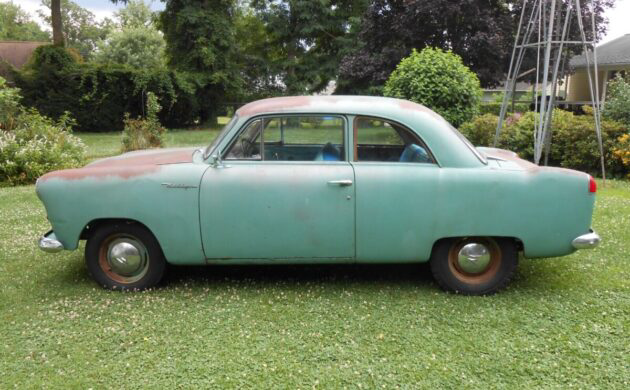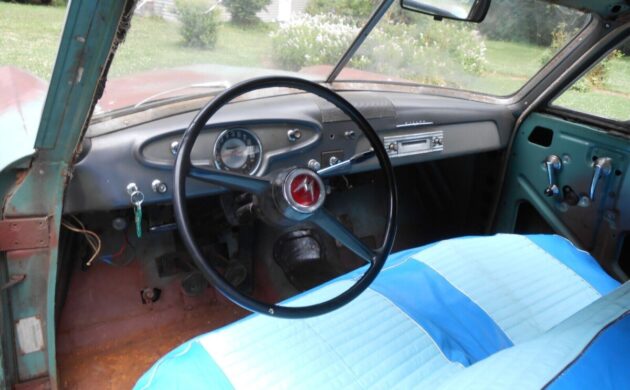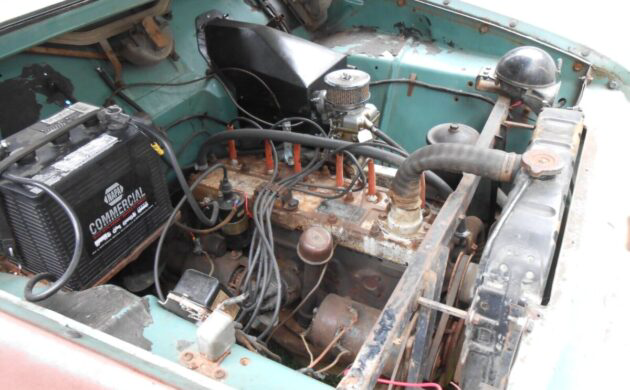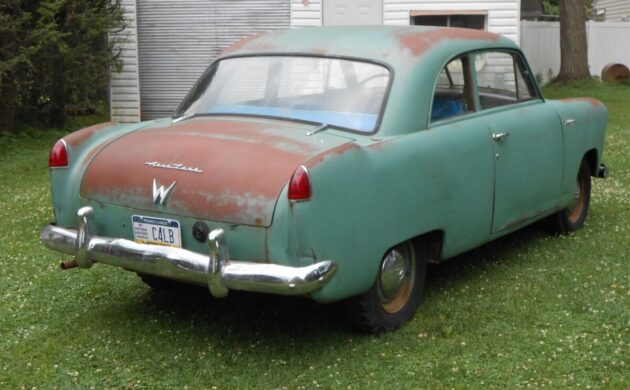Enthusiasts considering a first restoration project can find the prospect daunting. The thought of scraping and grinding away years of accumulated rust and welding in new steel can see many throw the entire concept into the “too hard” basket. That isn’t the case with this 1952 Willys Aero Lark. It is a solid survivor that promises a rewarding restoration experience. If that sounds too tempting to resist, it is listed for sale here on eBay in Langhorne, Pennsylvania. You could drive this classic home by handing the seller $8,000. If that figure seems too rich for you, they leave the option to make an offer. Our own Russell Glantz unearthed this beauty for us.
Willys introduced its “Aero” range of passenger cars for the 1952 model year, with the Lark representing its entry-level offering. It didn’t sell in the numbers expected, and many attribute this to its lack of luxury features and “Plain Jane” appearance. However, its low price attracted enough buyers to justify its existence. The seller supplies no information on this Lark’s history, but it appears original and unmolested. Its panels wear Inverness Green paint that is worn through in places. It would benefit from a cosmetic refresh, with only a few minor dings and bruises on the new owner’s “to do” list before they can apply a fresh coat of paint. Alternatively, they may elect to hit it with a coat of clear to protect its original survivor appearance. This is viable because there is no significant rust requiring attention. The seller describes the car as 99% rust-free but doesn’t indicate where the 1% might be. Nothing is visible in the exterior shots, and a lack of carpet allows us to see that the floors are rock-solid. Willys didn’t bless the Lark with acres of chrome trim, and apart from some dents in both bumpers, it appears to be in generally good condition. The buyer may need to search for some glass because the driver’s windshield is cracked, while the passenger side and back window are scratched.
Apart from the paint, another aspect of this Lark begging for love is its interior. The seller has thrown on some aftermarket slipcovers, but the upholstery has seen better days. They removed the door and rear quarter trims, but these are included. I can best describe their condition as ordinary, and since the buyer will struggle to locate a trim kit, these items could serve as a template for a retrim by an upholsterer. The wheel has a repairable hole, with the painted surfaces acceptable for a survivor. If the buyer elects a thorough restoration, the interior component of the project should prove straightforward.
While most of the 1952 Aero range received the Willys Hurricane or Super Hurricane engines, the Lark rolled off the line with the 161ci Lightning flathead six. It may have only produced 75hp, but thanks to a weight of a mere 2,487lbs, it gave the owners excellent performance for the price. The original owner ordered this with a three-speed manual transmission with optional overdrive, and this choice should make this classic an accomplished open-road cruiser. If the buyer wants to tackle a cross-country journey, this beauty should happily cruise all day at 60mph. The seller fitted a new and upgraded carburetor, although they include the original in the deal. They provide no specific details on how this Willys runs or drives, but the impression they give looks positive.
Restoration projects come in all shapes and sizes, and each will present its own unique set of challenges. This 1952 Willys Aero Lark shows enormous promise, with its originality and lack of rust its strongest attributes. The 1952 Willys “Aero” series found 31,363 buyers, although only 7,474 of those selected the entry-level Lark. That was despite the Lark’s sticker price sitting an enormous 13% lower than the next offering in the range. Today, finding a good example without rust suitable for restoration is challenging, but that is the opportunity this one presents. With forty-three people watching the listing, I won’t be surprised if it finds a new home fairly quickly.







Thanks to Adam for a great writeup. Not being from the US( I think) it’s not easy trying to convey the message of this car. It almost brings a tear to my eyes. These are the cars our parents bought just starting their families, and on a tight budget. Younger folks may not know ( or care) but after the war, and for a good 10 years after, easily, things were not good for Americans. Cars then were merely an appliance, the cheaper the better. To be clear, 30K units for an “orphan” car is still a lot. All these were for, was wheels to and from work and rarely ventured outside of city limits. The O/D indicates, this person did do some traveling, but roads weren’t what they are today, and was more of a better gas mileage/ less engine wear feature, than higher cruising speeds.
Obviously this car was well hidden, or surely would have been a gasser by now, and more than likely, will succumb to that fate, and that’s okay too.
I may be alone saying this, but wouldn’t it be nice if THIS was all that was needed in cars again? Never happen,,,,still a very cool find.
If you are talking about WW II, the years 1945-1955 were not too shabby for Americans. There were jobs and the GI Bill for those wanting to go to college. Suburban housing tracts were being put up like crazy. Anybody living in Europe or the UK during that decade would have been thrilled by what they saw in the good ‘ol USA.
In the good old UK after WW 2 we were still on food rationing until 1952/3. My father owned one of only 3 cars in our very long street and it was only an old Hillman Wizard. Now there is nowhere to park in the same street, even in daytime!
yup merica was boomin. Lotsa jobs, sent the women back home, free college, etc. We were doin so well we took care of some of the other countries.
I think the Lark deserves a good museum, many of them. Its goin in the right direction today, no more bent6, use the 4, turbo it. Develop the hybrid till they can get the EV goin. Keep the oil in the ground… plastic is in the air, oceans, Mt tops – U process a credit card size thru your body a day. No wonder the leading cause of death in old age is cancer.
I DO like the looksa this esp better than the flyin saucers most drive today. But I’m justa ol man yappin…
In the late seventies a neighbor offered me one of these for $100.00. That would be a little over $500.00 today. His father had bought it new and I’d say it was in a little better shape than the feature car here. No rust or dents and was always garage kept. It was maroon with tan interior. I turned it down. I should have bought it.
We all have a shoulda/coulda story…
I have more than my share of these stories. Also in the late seventies, I turned down a running, driving 1957 Chevrolet BelAir Convertible for $500.00 because someone had removed all the stainless side trim. That was it’s only flaw.
The list is almost endless.
Wow. An amazing survivor; I sure hope it doesn’t succumb to the torch to become a gasser. An entry level orphan that survived 70 years unmolested, only to butchered up .. that would be a horrible fate. There can’t be more than a handful left in ANY condition. A piece of history that should be preserved
Willys actually had a prototype as early as 1946 for the sellers car market that was going on at the time. Only problem was that it burned up in a fire. Willys them went back to the drawing board and came up with this model starting in 1952. There were ultimately 3 models to choose from: Willys Aero Falcon, Lark and Aero Ace. Problem was that the price point on these cars put them out of the market. You had to pay more for a 4 cyl Willys than a 6 cyl Plymouth. By 1955 it was over even with the introduction of the Willys Bermuda. After that, Kaiser moved all auto production to Argentina.
The big three drove out competition with economy of scale—or deliberately underpricing their cars. As Lance said, you could buy a six cylinder Plymouth for less money. I guess I’ve always loved offbeat cars. When I was a teenager in the late 50s, someone down the street had a Willys Aero. I remember it to this day because it was the only one I had ever seen.
I think the Willys Aero went to Brazil and the Kaiser went to Argentina. I guess the Henry J had no takers? Too bad as Americans by 1955 wanted acres of chrome and OHV V-eights.
“and the Kaiser went to Argentina.”
With a few of his close pals from Berlin.
Is that front windshield actually a two piece, or is it a one piece with a fake divider? I don’t know why they would do that, but I got to wondering why they would have a curved glass two piece windshield. Then I looked at the back glass and It looks to me as if the front and back glass are the same.